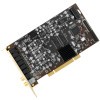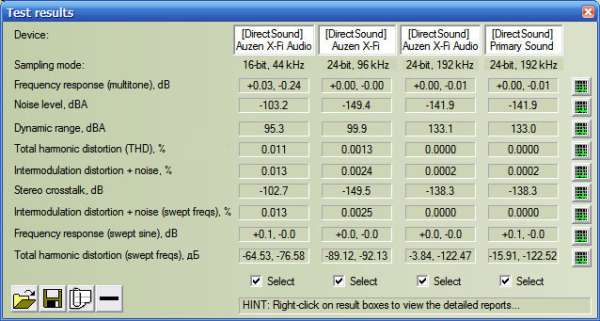- Qualcomm Launches Snapdragon 4 Gen 2 Mobile Platform
- AMD Launches Ryzen PRO 7000 Series Mobile & Desktop Platform
- Intel Launches Sleek Single-Slot Arc Pro A60 Workstation Graphics Card
- NVIDIA Announces Latest Ada Lovelace Additions: GeForce RTX 4060 Ti & RTX 4060
- Maxon Redshift With AMD Radeon GPU Rendering Support Now Available
Auzentech X-Fi Prelude

Finally! We are beginning to see Creative’s chipset offerings being used in other manufacturers sound cards. The first such product is Auzentech’s X-Fi Prelude, which we have on the test bench today. Though it excels in some regards, we find out that it has a lot of room for improvement.
Page 4 – Testing
Ok, now that we’ve discussed the X-Fi Prelude let’s see what it has to offer the end user. First we’ll start off with a look at the difference between the X-Fi Prelude and the X-Meridian in 3DMark ’03 gaming sound test.
|
Test
|
X-Fi Prelude
|
X-Meridian
|
| No Sounds | 79.5 FPS | 72.1 FPS |
| 24 Sounds | 70.3 FPS | 62.4 FPS |
| 60 Sounds | 64.3 FPS | N/A |
Well, we see that there’s a minimal improvement with the Prelude on the tests run but the fact that the margin stays pretty much the same from no sounds to 24 sounds there’s no telling if the card or some other variable is to thank for the change.
- System As Tested
- X2 3800+ @ 2750Mhz
- ASUS A8N32-SLI Deluxe
- 2 x 1GB PC4400 Corsair XMS Pro @ 275Mhz (550Mhz double pumped)
- EVGA 7950GT SuperClocked in SLI @ 626 Core, 780 Mem (1560Mhz double pumped)
- Seagate 500gig 7200.9 SATA II
- Western Digital WD1600JB 160gig SATA
- Samsung 16X DVDR/RW
- Samsung 16X DVD-Rom
- Ultra X3 1000W
- Swiftech H20-220 Apex Ultra water cooling plus 2 x MCW60 GPU blocks and BIP X-Flow rad
- Silverstone TJ09 case
The second round of gaming tests will consist of two runs on GRAW2 for each card. The tests were run at two different save points and started after the game had fully loaded and stabilized. Both tests use the same save points for each card and were conducted in such a way as to be as close to identical as possible.
|
X-Meridian
|
1st
|
2nd
|
| Min. | 0 | 23 |
| Max. | 67 | 45 |
| Avg. | 30.927 | 33.000 |
Hmmm… it hits zero at one point in test one. I ran it twice and got the same results both times although I never noticed a difference. If it dropped to zero it did it for a split second. Test two looks far better with a minimum frame rate that’s not low enough to be a slide show, most movies display at close to 23FPS and they look perfectly fluid and the game was pretty fluid the entire time.
|
X-Fi Prelude
|
1st
|
2nd
|
| Min. | 13 | 32 |
| Max. | 54 | 63 |
| Avg. | 46.058 | 47.800 |
The Prelude fares a little better in the first test, it never hits zero and instead drops to a minimum of 13FPS, the maximum drops to 54FPS but the average is considerably better at a touch over 46FPS. The second test shows the Prelude really leveraging the onboard DSP. The minimum comes up to a nice 32FPS while the maximum comes up to 63FPS and the average picks up nearly 15FPS. It shows that the onboard DSP is really helping to improve the overall gaming experience.
I decided to give RightMark Audio Analyzer 6.05 a spin, I got some interesting results.

The first round I threw the controls into "Game" mode and turned off all effects and set the record to "What U Hear" so that the loopback was done internally before the OPAMPs so the output levels wouldn’t run the risk of becoming damaging to the input of the card, say if I slipped or something and sent the full 5V of the output screaming into the auxiliary input.
I tested it at 16 bits at 44kHz in Direct sound, named device, 24 bits 96kHz named device, 24 bits 192kHz named device and 24 bits 192kHz primary device. The frequency response was pretty flat in every test I threw at it, very nice.
The noise levels were low in 16 bit mode but moving up to 24 bits lowered it to levels better than Creative’s offerings except the Elite Pro which ran $325 when it was initially introduced. Of course now it can be had for a few dollars more than the X-Fi Prelude. But by specs the Elite Pro is rated for 116db SNR so it’s a minor increase if any… this is considering that the Prelude is rated for 120db SNR.
The rest of the numbers look pretty good, the distortion is low enough to bring a smile to any audiophile’s face and the dynamic range is right up there with upper end audio equipment.

The next round I decided to set the recording device directly to the Wave output, this gave me the truest version of the waveform from RMAA. The results are rather interesting. We see a dramatic improvement in the 16 bit test run in the noise levels. We also see a marked improvement in crosstalk.
Moving to the first 24 bit test (all were run as outlined in the first group) we see a dramatic improvement in the noise levels and the crosstalk. The dynamic range suffers a bit as does the distortion in the swept frequencies. The next test sees similar improvement in the S/NR (noise level) and a huge improvement in the dynamic range. The THD drops to none the crosstalk stays insanely low. Wow, this thing is pretty accurate on the upstream side. Perfect would show no deviation from the test signal since we’re recording from the source. Sadly nothing’s perfect but this shows what’s being lost the further we go into the signal chain.
Now, I started getting strange aberrations in the input/output in RMAA. It’d report channel leakage yet the crosstalk (another term for leakage) scores would be fine. Then I started getting clipping errors (clipping occurred in 0.000% of the samples) so I went and got a loopback cable. What I found was rather disappointing:

I ran the tests all at 24 bits 96kHz in both named and primary device modes… it has some bearing but I’ll get to that. We see here that the noise levels with the loopback cable (tests 1 and 3 from left to right) have significantly higher noise levels (10 db is what a human perceives as an acoustic doubling in volume) because we’re picking up 1.5 times the noise on the loopback. Tests 2 and 4 are both running on "What u hear" and the dynamic range and noise levels are markedly better.
Oddly, the bass levels are boosted and the treble is down by nearly a full db yet I had the levels set to flat in all three test groups and all all three groups were run in "game" mode with all effects turned off. I tried in the other two modes but they had a curve similar to what we see in group three. I can only attribute this behavior to the drivers, somehow it’s not fully releasing the EQ when disabled. The stereo crosstalk was also lower when the loopback cable was used.
The whole reason I had run named and default driver tests was the clipping and channel leakage I’d mentioned earlier. In one driver mode (24 bit 192kHz named) I got those errors and in the other (24bit, 192kHz default) they were absent. After a while I got the leakage and clipping errors irregardless of the mode used.
This is a sad turn of events because I really had high hopes for the X-Fi Prelude. This has me wondering if other X-Fi cards suffer from this. The upside is that compared to the Audigy 4 that Rory compared the Xonar against, the X-Fi Prelude fares better. This is the problem with relying on drivers from Creative, they tend to be a bit odd for lack of a better word. C-Media based cards might do well with reference drivers but given the complexity of the X-Fi chip and how far removed the Prelude is from any other X-Fi variant Auzentech really should look into coming up with their own proprietary driver.
Speaking of drivers, let’s take a look at them.
|
|
Support our efforts! With ad revenue at an all-time low for written websites, we're relying more than ever on reader support to help us continue putting so much effort into this type of content. You can support us by becoming a Patron, or by using our Amazon shopping affiliate links listed through our articles. Thanks for your support!




